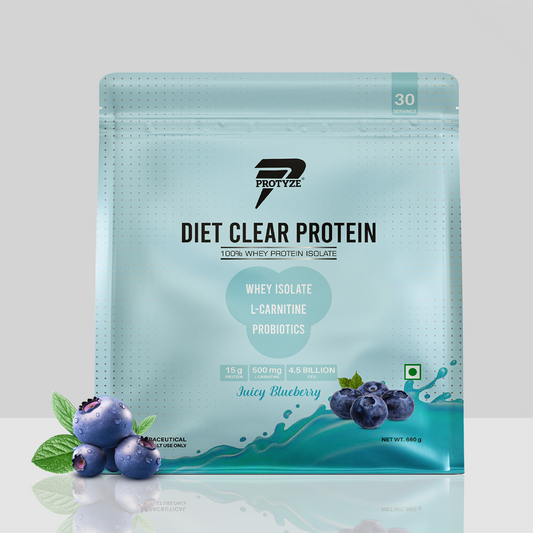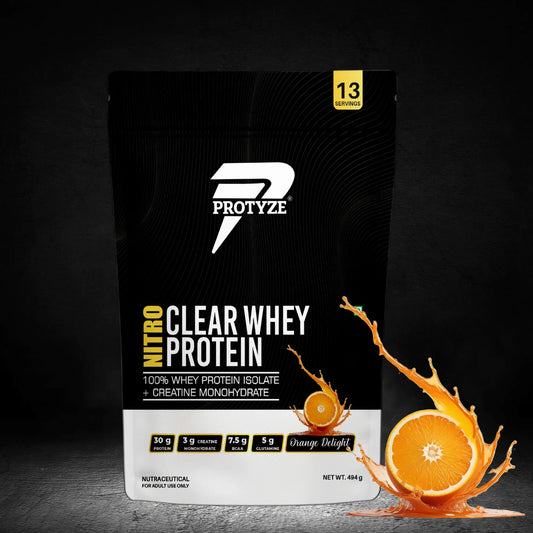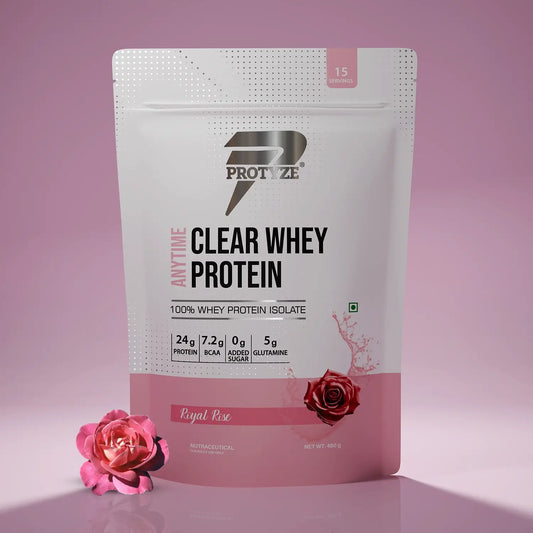Whey protein is a cornerstone of fitness nutrition, prized for its ability to support muscle growth, recovery, and overall health. As a complete protein derived from milk, it’s a go-to supplement for athletes, fitness enthusiasts, and those seeking balanced nutrition. In India, where vegetarian diets and lactose sensitivity (~60% of the population) are common, whey protein offers a convenient way to meet protein needs.
This blog explores what whey protein is, its types (concentrate, isolate, hydrolysate), and its benefits, tailored for Indian lifestyles with cultural context. We’ll highlight Protyze Anytime Clear Whey, Protyze Diet Clear Whey, and Protyze Nitro Clear Whey to illustrate how these products align with specific fitness goals.
What is Whey Protein?
Whey protein is a high-quality protein derived from the liquid byproduct of cheese production, containing all nine essential amino acids. It’s rich in branched-chain amino acids (BCAAs), particularly leucine (~2-3g per 25g serving), which drives muscle protein synthesis, per a 2018 study. With a bioavailability score of ~100, whey is rapidly absorbed, making it ideal for post-workout recovery.
In India, where dietary protein from sources like dal (~9g/100g) or paneer (~20g/100g) may fall short for active individuals (needing 1.2-2.2g/kg body weight), whey protein supplements bridge the gap. Products like Protyze Anytime Clear Whey, with 24g protein per serving, offer a versatile, 99% lactose-free option, mixed with water for easy digestion in humid climates.
Key Features of Whey Protein
- Complete Protein: Contains all essential amino acids for muscle repair and growth.
- Fast-Digesting: Absorbed in ~1-2 hours, ideal for post-workout.
- Versatile: Used for muscle gain, fat loss, or general health.
- Indian Context: Complements vegetarian diets and supports lactose-sensitive users with isolate-based formulas.
Types of Whey Protein (Detailed Breakdown)
Whey protein is available in several forms, each varying in its composition, processing level, and suitability based on health goals and dietary preferences. The most common types include Whey Protein Concentrate (WPC), Whey Protein Isolate (WPI), Whey Protein Hydrolysate (WPH), and the more recent innovation, Clear Whey Isolate. Understanding the differences among these can help you choose the right one based on your fitness level, digestion tolerance, budget, and taste preference.
1. Whey Protein Concentrate (WPC)
Whey Protein Concentrate is the least processed form of whey, meaning it retains more of the beneficial nutrients found in whole dairy. It contains approximately 70–80% protein, with the remaining portion consisting of carbohydrates (mainly lactose) and fats. Because of this balanced profile, WPC is more nutrient-dense and cost-effective, making it a popular choice for beginners and general health enthusiasts. However, the presence of lactose may cause discomfort for those who are lactose intolerant.
Key Highlights
- Contains 70–80% protein per serving
- Includes small amounts of lactose and fats
- Affordable and widely available
- Retains immune-boosting compounds like immunoglobulins
- Best suited for beginners or those with no lactose issues
2. Whey Protein Isolate (WPI)
Whey Protein Isolate undergoes additional filtration to remove most of the fats and lactose, resulting in a product that is 90–95% protein by weight. It’s ideal for those aiming to build lean muscle without extra calories or for individuals who are lactose intolerant. Isolates are also digested more rapidly than concentrates, which makes them highly effective for post-workout recovery. Although slightly more expensive, the purity and performance benefits make it a favorite among athletes and fitness professionals.
Key Highlights
- Contains 90–95% pure protein
- Low to zero lactose content
- Virtually no fat or sugar
- Fast digestion and absorption
- Ideal for weight loss, lean muscle gain, and lactose-intolerant users
3. Whey Protein Hydrolysate (WPH)
Also known as hydrolyzed whey, this is the most processed and advanced form of whey protein. It is pre-digested, meaning the protein chains (peptides) are broken down into smaller fragments for rapid absorption. This makes it the fastest digesting whey protein available and the least allergenic. WPH is commonly used in clinical nutrition, sports rehabilitation, and for individuals with sensitive digestive systems. However, it tends to be more expensive and may have a slightly bitter taste.
Key Highlights
- Pre-digested for fastest absorption
- Highly suitable for people with digestive issues
- Contains minimal allergens
- Often used in medical or clinical nutrition
- Premium pricing due to processing level
4. Clear Whey Isolate (New-Age Option)
Clear Whey Isolate is a newer and innovative form of whey protein made from whey isolate, but designed to be light, refreshing, and juice-like, rather than a creamy shake. It’s formulated to deliver 20–25g of high-quality protein per serving, with zero sugar, zero fat, and no milky texture. This makes it an excellent choice for people who dislike the heaviness of traditional protein shakes or want a protein drink that’s easy to sip anytime—especially in hot weather or post-cardio workouts. Additionally, it’s ideal for those who experience bloating or digestion issues with creamy shakes.
Key Highlights
- Juice-like, light texture—no milky feel
- Contains 20–25g of whey isolate protein
- Zero added sugar and fat
- Digests quickly, no bloating
- Available in fruity flavors like mango, peach, lychee, orange
- Great for on-the-go lifestyles and refreshing post-workout hydration
How Whey Protein is Made
Whey protein, one of the most popular and widely used forms of protein supplementation, is derived from milk. The process of making whey protein involves several steps that transform raw milk into the high-quality protein powder we see on store shelves. Here's a detailed breakdown of how whey protein is made:
1. Milk Collection
The process begins with fresh milk, which is typically sourced from dairy cows. The milk is collected and transported to a dairy processing facility for further processing.
2. Separation of Milk Components
Milk consists of several components: water, lactose (milk sugar), fat, and proteins (mainly casein and whey). The first step in whey protein production is separating these components. This is done through a process called ultrafiltration or centrifugation, where the milk is spun at high speeds to separate the cream (fat) from the liquid whey and casein proteins.
- Skim Milk: The fat is removed, leaving behind skim milk.
- Whey and Casein: The liquid portion contains both whey protein and casein, but they are separated into different forms through filtration.
3. Whey Protein Extraction
Once the fat and casein are removed, the next step is to separate the whey protein from other components in the liquid. The liquid whey contains a combination of proteins, carbohydrates (lactose), and some minerals. To extract the whey protein, the liquid is passed through a microfiltration or cross-flow filtration process, which uses special membranes to filter out unwanted substances, such as fats, lactose, and minerals, leaving behind the protein content. At this stage, whey protein exists in different forms:
- Whey Protein Concentrate (WPC): Contains varying levels of protein (usually 70-80%), with fats and carbohydrates still present.
- Whey Protein Isolate (WPI): A purer form of whey protein (usually 90% or higher protein content), with most fats and carbohydrates removed.
- Whey Protein Hydrolysate (WPH): A pre-digested form of whey protein that is broken down into smaller peptides for quicker absorption.
4. Concentration and Purification
The whey protein is further concentrated and purified to remove any remaining traces of lactose, fats, and minerals. This step often involves ion exchange or ultrafiltration techniques to ensure the protein is as pure as possible.
- Ion Exchange: In this method, whey proteins are passed through a resin column that attracts and removes unwanted components (like minerals), leaving behind a higher concentration of protein.
- Ultrafiltration: This involves using a fine membrane to filter the protein while maintaining its nutritional value. The membrane allows only the desired protein molecules to pass through.
5. Drying
After the whey protein is filtered and concentrated, the next step is to turn it into powder. This is done by spray drying, a process where the liquid whey protein concentrate or isolate is sprayed into a hot air chamber. The heat evaporates the moisture, leaving behind fine whey protein powder. At this stage, the protein is almost pure, with minimal carbohydrates and fats. The drying process also helps increase the shelf life of the protein, making it suitable for long-term storage.
6. Flavoring and Additives (Optional)
Many commercial whey protein powders have added flavors, sweeteners, or other ingredients to improve taste and texture. These can include:
- Artificial or natural flavors: To make the protein more palatable.
- Sweeteners: To add sweetness, especially in protein powders that are low in sugar.
- Probiotics or digestive enzymes: To enhance digestion and absorption.
These ingredients are blended with the dried whey protein in precise amounts, depending on the product formulation.
7. Packaging
Once the whey protein is flavored and blended (if necessary), it is packaged into containers. The powder is sealed in airtight containers or bags to maintain its freshness, shelf life, and quality. Packaging is usually done in bulk, and the protein is distributed to different locations or retail outlets. This packaging often includes product information, such as serving sizes, nutritional facts, and flavor details.
8. Quality Control
Throughout the entire process, there are rigorous quality control measures in place to ensure the final product meets safety and quality standards. These include:
- Testing the milk for contaminants.
- Checking the protein content in the final product.
- Ensuring the purity of the protein (especially for isolates).
- Monitoring the drying process to ensure proper moisture content.
9. Storage and Distribution
Once packaged, whey protein is stored in controlled environments to maintain its quality. From there, it is distributed to retail stores or directly to consumers, where it can be used as a dietary supplement.
Benefits of Whey Protein
Whey protein offers a range of benefits, from muscle building to health optimization, supported by science and adaptable to Indian lifestyles. Below are the key advantages, with examples of how Protyze products align.
1. Muscle Growth and Recovery
- How It Works: Whey’s high leucine content (2-3g/25g serving) triggers muscle protein synthesis, increasing muscle mass by 0.5-1 kg in 6-8 weeks with strength training, per a 2019 study.
- Application: Post-workout shakes (20-30g protein) optimize recovery. Protyze Nitro Clear Whey (30g protein, Blueberry Crush flavor, with creatine) enhances performance and muscle gains for serious athletes.
- Indian Context: Complements gym routines or home workouts (squats, push-ups), supporting protein needs (110-155g daily for 70kg) alongside paneer or eggs.
2. Weight Management and Fat Loss
- How It Works: Whey increases satiety and preserves muscle during calorie deficits, aiding fat loss (~0.5-1 kg in 4-6 weeks), per a 2020 study. Its thermic effect boosts metabolism by ~100 kcal/day.
- Application: Use as a low-calorie snack or meal replacement. Protyze Diet Clear Whey (15g protein, ~60 kcal, Juicy Lychee flavor) with probiotics supports weight management and gut health, ideal for fat loss.
- Indian Context: Pairs with low-calorie Indian meals (moong dal khichdi, ~200 kcal) to maintain a 500 kcal deficit.
3. Improved Digestion and Gut Health
- How It Works: Isolate-based whey minimizes lactose, while some formulas add probiotics to enhance gut health, reducing bloating by 20%, per a 2021 study.
- Application: Protyze Diet Clear Whey, mixed with water, delivers probiotics and 15g protein, easing digestion for lactose-sensitive Indians.
- Indian Context: Complements fermented foods like idli or chaas, common in Indian diets, for gut microbiome balance.
4. Enhanced Immunity and Energy
- How It Works: Whey’s immunoglobulins and amino acids (e.g., glutamine) support immune function, reducing illness frequency by 15%, per a 2018 study, and stabilize energy via protein metabolism.
- Application: Daily shakes maintain energy and immunity. Protyze Anytime Clear Whey (24g protein, Mango Peach flavor) is versatile for any time, supporting active lifestyles.
- Indian Context: Boosts resilience in urban settings with pollution or monsoon-related health risks.
5. Convenience and Versatility
- How It Works: Whey is quick to prepare, portable, and adaptable for shakes, smoothies, or recipes, delivering 20-30g protein in minutes.
- Application: Use Protyze Anytime Clear Whey or Protyze Nitro Clear Whey for post-workout or on-the-go nutrition.
- Indian Context: Fits busy schedules (e.g., office commutes) and festive seasons (Diwali), replacing sugary mithai (~200 kcal).
Timeline for Benefits
- 1-2 Weeks: Improved recovery, less soreness, and higher energy.
- 4-6 Weeks: Visible muscle tone, 0.5-1 kg fat loss, or muscle gain with training.
- 8-12 Weeks: Sustained strength, immunity, and body composition changes.
Choosing the Right Whey Protein
Selecting the best whey protein depends on your goals, budget, and dietary needs:
- Muscle Gain: Choose high-protein isolate or hydrolysate with added performance boosters. Protyze Nitro Clear Whey (30g protein, creatine) is ideal for bulking.
- Weight Loss: Opt for low-calorie isolate with extras like probiotics. Protyze Diet Clear Whey supports fat loss and gut health.
- General Health: Use versatile isolate for daily use. Protyze Anytime Clear Whey fits any goal with 24g protein.
- Indian Context: Prioritize 99% lactose-free formulas for digestibility, FSSAI-approved for safety, and flavors (Nimbu Pani, Juicy Mango) that suit Indian tastes.
- Dosage: Aim for 20-30g protein per serving, 1-2 times daily, mixed with 200-300ml water.
Frequently Asked Questions (FAQs)
Q1: What is whey protein and how is it made?
Ans: Whey protein is a high-quality, complete protein derived from milk during the cheese-making process. When milk is curdled, the liquid portion that separates is called whey. This whey is then processed and dried into a powdered form or turned into clear liquid beverages for convenient consumption.
Q2: Is whey protein vegetarian?
Ans: Yes. Whey protein is derived from milk, making it 100% vegetarian. It is suitable for lacto-vegetarians, which includes most vegetarians in India who consume dairy.
Q3: Can lactose-intolerant individuals take whey protein?
Ans: Yes, especially whey protein isolate or clear whey isolate. These are filtered to remove most lactose. Protyze Clear Whey products are 99% lactose-free, making them ideal for individuals with lactose sensitivity.
Q4: What’s the difference between whey concentrate, isolate, and hydrolysate?
- Concentrate: ~70–80% protein, contains some lactose and fats. Budget-friendly, good for beginners.
- Isolate: ~90–95% protein, very low in lactose and fat. Great for lean muscle, weight loss, and digestion.
- Hydrolysate: Pre-digested for fast absorption. Ideal for medical use or sensitive stomachs.
Q5: What is clear whey isolate, and how is it different?
Ans: Clear Whey Isolate is a newer form of whey isolate that mixes like a juice—light, non-creamy, and refreshing. It’s easy to digest and ideal for Indian weather and post-workout hydration. Protyze Clear Whey is a prime example with fruit-based flavors.
Q6: How much whey protein should I take daily?
Ans: It depends on your goals:
- General fitness: 20–25g once daily
- Muscle gain: 25–30g twice daily (post-workout and/or breakfast)
- Weight loss: 15–25g as a snack or meal replacement
Adjust based on your dietary protein intake and body weight (aim for 1.2–2.2g/kg).
Q7: Is whey protein safe for long-term use?
Ans: Yes. Numerous studies support the safety of whey protein for long-term use when taken within recommended daily protein limits. It supports muscle, metabolic, and immune health.
Conclusion
Whey protein is a powerful tool for muscle growth, weight management, gut health, immunity, and convenience, with concentrate, isolate, and hydrolysate catering to diverse needs. In India, where vegetarian diets and lactose sensitivity shape nutrition, isolate-based products like Protyze Anytime Clear Whey (24g protein), Protyze Diet Clear Whey (15g protein, probiotics), and Protyze Nitro Clear Whey (30g protein, creatine) offer 99% lactose-free, water-based solutions for fitness and health. Whether you’re building muscle, losing fat, or boosting energy, whey protein, paired with Indian staples (dal, paneer), empowers your 2025 goals. Choose wisely and fuel your journey!
TL;DR
Whey protein is a complete, fast-digesting protein ideal for muscle gain, fat loss, and overall health. It comes in four types—Concentrate, Isolate, Hydrolysate, and Clear Whey Isolate—each with varying levels of purity and digestion speed. In India, where vegetarian diets and lactose sensitivity are common, isolate-based whey like Protyze’s Clear Whey range (Anytime, Diet, and Nitro) offers 99% lactose-free, water-based, fruity protein drinks. Use Nitro (30g protein + creatine) for muscle gain, Diet (15g protein + probiotics) for weight loss, and Anytime (24g protein) for daily health. Whey protein supports recovery, gut health, energy, and immunity—essential for active Indian lifestyles in 2025.

![What is Whey Protein | Whey Protein Types and Benefits [Detailed Guide]](http://www.protyze.com/cdn/shop/articles/What_is_whey_protein_blog_banner.png?v=1753162834&width=1100)



